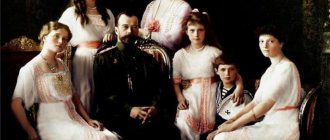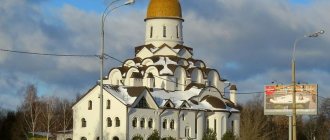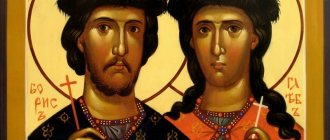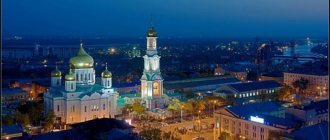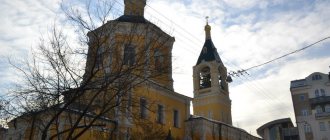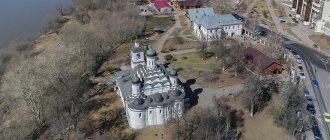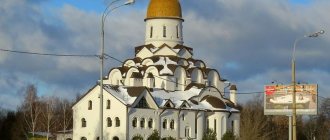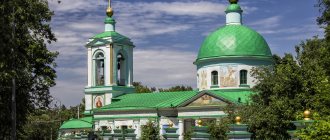No. 26 (635) / July 4 '11
Pilgrimage
to Ryazan
In 2000, with the blessing of Metropolitan Simon, a parish of the church was formed, first in the name of St. Nicholas, since the Holy Royal Passion-Bearers had not yet been glorified, but they had already decided to start building a temple in their honor, believing that they should be glorified. Vladyka Simon thought the same thing, so he blessed this construction. Soon this happened. Then the parish was renamed in honor of the Holy Royal Passion-Bearers. On December 31, 2000, the cross was erected and consecrated. A few days later, the unexpected happened: the cross was cut down and trampled under foot (traces of soles remained on the cross). The parishioners did not retreat; an akathist was read daily in front of the restored cross.
The land was leased in 2002, and construction of the temple began: the ceremony of laying the first stone for the foundation was completed, a wooden frame for the temple was delivered, which was soon installed and consecrated. The consecration was performed by Metropolitan Simon. The wooden temple did not last long, just over a year: on the night of November 8-9, it was burned. Those who committed the arson were never found, but by that time construction of a stone temple had begun. The consecration of the new church on October 12, 2008 was performed by Archbishop Pavel of Ryazan and Kasimov.
There are especially revered icons in the temple. One of them, the Savior Not Made by Hands, late 19th - early 20th centuries, was kept in a private house, and when the house was demolished, the icon was transferred to the temple. The Icon of the Sovereign Mother of God was purchased in Moscow on February 28, 2004. After the prayer service with an akathist, she streamed myrrh, and the stream of myrrh lasted all day. The icon of the Holy Royal Passion-Bearers was brought on July 17, 2006, a prayer service was served, and a religious procession took place. And then two miracles happened at once: one woman had difficult financial difficulties for a long time, and after praying before the icon, all her problems were easily and quickly resolved; another woman’s tumor miraculously disappeared, although the timing of the operation had already been determined.
Sonkovo village, Tver region.
The house assigned church in honor of the Holy Royal Passion-Bearers was opened on January 6, 2002 through the efforts of Archpriest Sergius Tsvetkov. The church is assigned to the Holy Cross Church in the village. Povodnevo, Sonkovsky district and is located in the temporarily provided premises of the village administration.
Perm
The parish was founded by the Cossacks of the Kama region in May 1997 and was originally called St. George.
In November 1997, on the territory of the hospital campus of the 9th medical unit in Perm, the parish opened a chapel in the name of the Holy Great Martyr and Healer Panteleimon. In the summer of 1998, it was significantly expanded and transformed into a hospital church.
On September 21, 2001, the parish founded a wooden church in honor of the Holy Royal Passion-Bearers in the Nagorny microdistrict of the Industrial District of Perm at the address: Architect Sviyazev Street, 19.
The first service, a festive prayer service in honor of the Holy Royal Passion-Bearers in the new church was held on July 17, 2002. On September 2, 2002, the first Divine Liturgy was celebrated.
On February 21, 2003, by Decree No. 47 of His Grace Irinarch, Bishop of Perm and Solikamsk, the parish of the Holy Great Martyr George the Victorious was transformed into the parish of the Holy Royal Passion-Bearers.
With the blessing of Bishop Irinarch, the Church of the Holy Royal Passion-Bearers is a Cossack Church.
Chernogorsk, Khakassia
Chapel in honor of the Royal Passion-Bearers at the Church of the Nativity of the Mother of God.
Izhevsk
In Izhevsk, this Holy Family was revered even before the Royal Passion-Bearers were canonized, religious processions took place, and icons were painted.
In 2002, a Worship Cross was erected at the Northern Cemetery of Izhevsk on the site of the future construction of a temple in honor of the Holy Royal Passion-Bearers.
In 2005, over several winter months, the temple building was erected. On May 9, Victory Day, crosses were installed on the domes; The Church of the Royal Passion-Bearers was opened. The improvement of the temple and territory was completed by the first patronal feast of the temple.
Kursk
The Church of the Royal Passion-Bearers in Kursk was consecrated on December 11, 2010. Built and decorated in just two years, the temple (author of the project V.N. Mikhailov, chief engineer M.I. Novikov) greeted parishioners and guests with magnificent decoration. To the right of the entrance there is a large full-length icon of the Holy Sovereign Emperor Nikolai Alexandrovich. The beautiful carved iconostasis was made by Shchigrov craftsmen from the Holy Trinity Brotherhood of the Kursk Diocese. In its bottom row, locally revered saints, on the right southern side there are icons of the Royal Passion-Bearers, Grand Duchess Elizabeth Feodorovna and nun Varvara, His Holiness Patriarch Tikhon. Icons of the Holy Tsar Nicholas are also placed on the main church chandelier. Truly, it is the “Royal Temple”, where prayer to the King of Kings is combined with prayer to the Holy Russian Tsar, who resides at the Throne of the Most High.
Moscow
At the Valaam courtyard in Moscow, even before 2000 (the official glorification), the Chapel of the Royal Martyrs appeared. This was a wise and courageous action for those times - to consecrate the chapel in honor of the yet unglorified saints! The then rector of the Valaam Monastery, Abbot Andronik (Trubachev), managed to receive a blessing from His Holiness the Patriarch to venerate the Royal Martyrs as “locally revered saints.” The chapel was painted with frescoes, which are still one of the most successful images of the Holy King and Queen. Here, those who pray for all of Russia, who hear sighs for every Russian person, are somehow especially experiencing the coming. It is very important to pray for the deceased, for our ancestors, for those who lived at a time when Russia abandoned the Tsar...
In other rooms:
Holy Land in Yasenevo, or a Very Unusual Temple
Estimated reading time: 4 minutes.
Unlike many other worldviews, our Orthodox faith is deeply rooted in real events. The Church confesses that in our Lord Jesus Christ God became man, like us in everything except sin - and this happened at a certain moment in human history and in a certain place.
Therefore, every Christian is so infinitely dear to the Holy Land, where our Lord Jesus Christ was incarnated, preached, died on the cross for us, and rose from the dead. Therefore, the flow of pious pilgrims from our country does not dry out - but only increases - who want to see with their own eyes the places where the saving deeds of the Lord took place, to walk along the roads along which He walked, to breathe the same air, to look at the same horizon.
Nowadays, traveling has become easier - but still not everyone can afford it. And centuries ago, only very few people could go to Jerusalem themselves. But the Holy Land has always been in the hearts of Orthodox Christians; That’s why here in Rus', the custom arose of reproducing holy places in churches and monasteries. The largest effort of this kind is the New Jerusalem near Istra - the Resurrection New Jerusalem Stavropegic Monastery, which was founded in 1656. Patriarch Nikon. During construction, places along the banks of the Istra River were given biblical names: Bethlehem, Galilee, Olivet, Garden of Gethsemane and Mount Tabor. Even the river was renamed Jordan here. In the monastery Temple, the Edicule was reproduced - the “royal bedchamber”, the tomb where the Lord was buried and resurrected.
The Edicule (Holy Sepulcher) was also reproduced on Valaam, in the famous Resurrection Skete. It was there, on Valaamai, that the spiritual children of Hegumen Melchizedek (Artyukhin), the rector of the Church of the Intercession of the Most Holy Theotokos, which was under construction, visited. They gave Father Melchizedek the idea to arrange the same in the Pokrovsk Church. But will this be appropriate, since just at this time the Edicule was being restored in the New Jerusalem? Father Melchizedek addressed this question to Vladyka Arseniy, Archbishop of Istra. Vladyka Arseny not only blessed this undertaking, but also unexpectedly added - “also the place of the Nativity of Christ!”
Here is how Abbot Melchizedek himself tells it:
“Everything started to come together long before we decided to implement this idea, the Lord took care of everything in advance. Let me give you a specific example. When I returned to the temple and began to look at where it would be possible to arrange a place for the Nativity of Christ, I remembered that a few months before that, the foreman of our construction, the servant of God Gregory, approached me and offered to make two arches of brick on the wall - in his opinion, this would emphasize the vaults of the temple. At first I thought that if you make arches, it will be more difficult to do the painting. But I still agreed. And only then did I remember that in Jerusalem the place of the Nativity of Christ is also in the arch - the place of Golgotha is also in the arch. When we sent our architect to make measuring drawings of the Edicule, the place of the Nativity of Christ, Golgotha, we discovered an amazing thing - the arch above the place of the Nativity of Christ turned out to be only 10 centimeters wider than in our temple, and our arch over Golgotha was only seven centimeters narrower , the one located in Jerusalem at the site of the Crucifixion of our Lord. If we had started doing this in advance, we would not have gotten to the size with such accuracy. Even when we do everything according to pre-drawn drawings, we always get a discrepancy of 10-15 centimeters... We all felt that this was some kind of special providence of God - the arches were built in advance, Vladyka Arseny blesses the place of Christmas..”
Soon the initiative was blessed by His Holiness Patriarch Kirill.
Thus, in the Pokrovsk Church, the most revered shrines of Jerusalem and Bethlehem were reproduced - the fourteen-rayed silver star, which marked the place of the Nativity of the Savior, Golgotha, the place where the Lord Jesus suffered the Crucifixion for us, the Stone of Anointing, on which His body was anointed with incense after being removed from the Cross, Holy Sepulcher, Edicule and tomb of the Blessed Virgin Mary.
Why is this so important, why is it so surprising and joyful that these shrines are reproduced here in Moscow? Someone will say - even though these are careful copies, even if they remind us of real places and events, but these are copies... This is not entirely true. In the Pushkin State Museum of Fine Arts there are many copies of famous works of art - one cannot say that this is meaningless; a copy, if it is faithful to the original, allows one to form the right impression about it - but the Church is not a museum.
In the Church, we do not just remember certain events in the history of our salvation, we are actually present at them, they become events in our lives that deeply change us. It is very important that in church prayers the word “today” is so often repeated. The Church overcomes space and time, and we, gathered here for prayer, greet Him, born in Bethlehem, preaching, coming to Jerusalem for free suffering, we find ourselves in the upper room with Christ and the Apostles, we see Him crucified for our sins, we bury Him together with Joseph of Arimathea, and we meet Him, rising from the tomb, with the jubilant “Christ is Risen!”
By kneeling in the Edicule here in Moscow, spiritually we find ourselves in Jerusalem; faith, prayer and reverent veneration of a shrine are never a “copy” - they are always the original. And we truly worship the holy places here, in Moscow, in Yasenevo, in the Church of the Intercession of the Most Holy Theotokos.
Photo by Vladimir Eshtokin
In the village of Peniki
It is located in the Lomonosov district of the Leningrad region, and received its name at a time when Finns lived on these lands, which belonged to Sweden until the beginning of the 18th century. There was a manor here where dogs were bred, hence the name "Penikkala" from the Finnish word for "puppy".
The idea of building a temple here for Tsar Nicholas and Tsarina Alexandra appeared among the Orthodox of the nearby city of Oranienbaum back in 2000. It was assumed that by 2005 the wooden church would have already been built, but its construction has not been completed to this day.
However, services are performed:
- in the martyr's chapel. George at the cemetery (village Langerevo) - liturgy on Saturdays from 10 a.m., requiem service at the same time from 1 p.m.;
- on Sunday the liturgy takes place in the church under construction from 10 a.m., and the night before from 5 p.m. there is an all-night vigil;
- In addition, services in the unfinished church take place on one weekday, according to the parish’s website, “according to a special schedule.”
The main shrine of the church under construction is the Sovereign Icon of the Mother of God, which, as is known, was revealed after Tsar Nicholas abdicated the throne. In front of her, as well as in front of the icon of the Royal Passion-Bearers, Saturday akathists are served from 17:00.
Address: Central St., 22, Peniki village
In Novosibirsk
Temple in honor of the passion-bearer Tsar Nicholas II in Novosibirsk
This city treats Nicholas II with particular reverence, since its very foundation is connected with the activities of the last Russian Tsar. The Ob station village, named Novo-Nikolaevsky, appeared thanks to the construction of the Trans-Siberian Railway, which was then supervised by the Tsarevich, the heir to the throne. And already as emperor, on December 28, 1903, he awarded Novo-Nikolaevsk the status of a city. Since 1912, by his decree, a new railway runs through the Ob station to Altai and Semipalatinsk, which makes the city a leading transport hub in Siberia and ensures its development.
Even before the revolution, the memory of the role of the tsar in the fate of Novo-Nikolaevsk were:
- chapel dedicated to his heavenly patron, St. Nicholas of Myra; it was erected for the 300th anniversary of the Romanov dynasty;
- The name of the main street of the city is Nikolaevsky Prospekt.
It is clear that it was the residents of Novosibirsk who responded vividly to the canonization of the Royal Passion-Bearers. The Orthodox community of the future church has been formed since 1998, but only in 2002 was the parish officially created. The site of the future church was a long-closed cemetery at the intersection of Voinskaya and Nikitin streets. .
Now the parish is collecting information about those buried here, and funeral litias are regularly served.
Interesting fact
By the providence of God, the foundation of the church on April 16, 2003 began with a prayer service in front of the shrine - the myrrh-streaming icon of the passion-bearing king, which then arrived on the Siberian land.
By 2007, a temporary temple was consecrated using donations from people. Currently, the construction of the capital building is being completed. This is a large single-domed church in the style of ancient Russian architecture. In the meantime, services are held in a temporary building daily from 8 (on Sundays - from 9) and 16 o'clock. Among the revered shrines:
- two images brought for the church from Athos, the Mother of God of Iveron and St. Nicholas;
- another icon of the Miracle Worker of Myra, also created on Athos, with a particle of his relics; a miraculous image was consecrated on the tomb of the holy city of Bari;
- an icon with part of the relics of the Montenegrin saint Stephen of Piper;
- image of the Royal Passion-Bearers.
The church has a children's Sunday school named after Tsarevich Alexy, a social service, and a library. The chapel of the Feodorovskaya Icon of the Mother of God (the Romanov family icon) at the maternity hospital is assigned to the parish.
Address: st. Nikitina, 105/1, Novosibirsk
